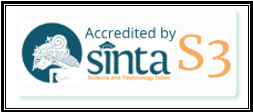IMPULSIVE BUYING PADA MAHASISWA PENGGUNA INSTAGRAM
DOI:
https://doi.org/10.22515/ajpc.v2i1.3556Keywords:
advertising, impulsive buying, hedonism, studentsAbstract
The lifestyle of hedonism is mushrooming among students due to the high intensity in using social media. Social media is used as a promotional media of products, thus resulting in the frequent appearance of advertisements on social media one of them instagram. The study aims to find out impulsive buying in student instagram users. The sample from this study is a student of Islamic psychology IAIN Surakarta class of 2018. Research using qualitative methods and research results are presented in qualitative descriptive form. The results showed someone impulsively buying a product that supports the style of life informant with a price of ≤ Rp. 150,000. Impulsive buying appears when scrolling up ads on Instagram. So it raises curiosity marked by following the online shop account. Therefore encourage informants to buy products as self-fertiliser. Hedonic motivation becomes one of the driving forces for someone to make purchases based on desire without paying attention to aspect of rationality.
Downloads
References
Afandi, A. R., & Hartati, S. (2019). Pembelian Impulsif pada Remaja Akhir Ditinjau dari Kontrol Diri. Gadjah Mada Journal of Psychology (GamaJoP), 3(3), 123. https://doi.org/10.22146/gamajop.44103
Arifianti, R., & Gunawan, W. (2020). Perilaku Impulse Buying Dan Interaksi Sosial Dalam Pembelian Di Masa Pandemi. SOSIOGLOBAL : Jurnal Pemikiran Dan Penelitian Sosiologi, 5(2), 43–60.
Astari, D. A. C., & Nugroho, C. (2017). Motivasi Pembelian Impulsif Online. 5(2), 33–46.
Dewi, P. D. P. (2014). Analisis Pengaruh Dimensi Motivasi Belanja Hedonis Terhadap Impulse Buying Konsumen Online Store di Instagram. 2(2), 0–5.
Fatmawati, N. (2020). Gaya Hidup Mahasiswa Akibat Adanya Online Shop. Jurnal Pendidikan Ilmu Sosial, 29(1), 29–38. https://doi.org/10.17509/jpis.v29i1.23722
Fitria, E. M. (2015). Dampak Online Shop di Instagram dalam Shopaholic di Samarinda. 1(3), 117–128.
Gunawan, R. (2021). Onlineshop Sebagai Cara Belanja di Kalangan Mahasiswa FISIP Universitas Riau. JOM FISIP, 8(1), 1–13.
Ilmalana. (2012). Analisis Motivasi Konsumen Online dalam Melakukan Impulse Buying pada Transaksi C2C Commerce (Studi pada Forum Jual Beli Kaskus). Universitas Indonesia.
Indika, D. R., & Jovita, C. (2017). Media Sosial Instagram Sebagai Sarana Promosi Untuk Meningkatkan Minat Beli Konsumen. Jurnal Bisnis Terapan, 1(01), 25–32. https://doi.org/10.24123/jbt.v1i01.296
Jamaludin, A., Arifin, Z., & Hidayat, K. (2015). Keputusan Pembelian (Survei Pada Pelanggan Aryka Shop di Kota Malang ). 21(1).
Kharis, I. F. (2011). Studi Mengenai Impulse Buying dalam Penjualan Online. fFakultas Ekonomi, Universitas Diponegoro.
Luthfiana, R. (2014). Analisis Kualitas Pelayanan, Promosi Dan Hedonic ShoppingMotives YangMempengaruhi Impulse Buying Dalam Pembelian Secara Online. Universitas Diponegoro.
Manggiasih, F. P., Widiartanto, & Prabawani, B. (2015). Pengaruh Discount , Merchandising , dan Hedonic Shopping Motives Terhadap Impulse Buying. Jurnal Ilmu Administrasi Bisnis, 4(4), 164–174.
Pertiwi, W. K. (2021). Pengguna Internet Indonesia Tembus 200 Juta, Hampir Semua “Online†dari Ponsel Artikel ini telah tayang di Kompas.com dengan judul “Pengguna Internet Indonesia Tembus 200 Juta, Hampir Semua ‘Online’ dari Ponselâ€, Klik untuk baca: Penulis : Wahyunanda Kusu. Kompas.Com. Retrieved from https://tekno.kompas.com/read/2021/02/24/07020097/pengguna-internet-indonesia-tembus-200-juta-hampir-semua-online-dari-ponsel.
Pratnyawan, A. (2019). Pengguna Facebook dan Instagram di Indonesia Terbesar ke-4 di Dunia. Hitekno.Com. Retrieved from https://www.hitekno.com/internet/2019/06/19/125012/pengguna-facebook-dan-instagram-di-indonesia-terbesar-ke-4-di-dunia
Rachmawati, V. (2009). Hubungan Antara Hedonic Shopping Value, Positive Emotion, dan Perilaku Impulse Buying Pada Konsumen Ritel. (2), 192–209.
Rook, D. W. (1987). The Buying Impulse. The Journal of Consumer Research, 14(2), 189–199.
Sari, C. A. (2015). Perilaku Berbelanja Online Di Kalangan Mahasiswi Antropologi Universitas Airlangga. Jurnal Antro Unair, 4(2), 205–216.
Sari, D. K. (2018). Peran In Store Stimuli Dalam Customer Impulse Buying Serta Implikasinya Terhadap Strategi Pemasaran Pada Minimarket. Eksis: Jurnal Riset Ekonomi Dan Bisnis, Vol.13(No.2), 101–110.
Septila, R., & Aprila, E. D. (2017). Impulse Buying Pada Mahasiswa di Banda Aceh. Psikoislamedia Jurnal Psikologi, 2, 170–183.
Siregar, N. F., & Rini, Q. K. (2019). Regulasi Diri Dan Impulsive Buying Terhadap Produk Fashion Pada Remaja Perempuan Yang Berbelanja Online. Jurnal Psikologi, 12(2), 213–224. https://doi.org/10.35760/psi.2019.v12i2.2445
Solomon, M. R., & Rabolt, N. J. (2009). Consumer Behaviour in Fashion. USA: Prentice Hall.
Talika, F. T. (2016). Manfaat Internet Sebagai Media Komunikasi bagi Remaja di Desa Air Mangga Kecamatan Laiwui Kabupaten Halmahera Selatan. Journal Acta Diurna, 5(1).
Tashandra, N. (2018). 80 Persen Konsumen Belanja Online Orang Muda dan Wanita. Kompas..Com. Retrieved from https://lifestyle.kompas.com/read/2018/03/22/155001820/80-persen-konsumen-belanja-online-orang-muda-dan-wanita?page=all
Verplanken, B., & Herabadi, A. G. (2001). Individual Differences in Impulse Buying Tendency : Feeling and No Thinking Individual Differences in Impulse Buying Tendency : Feeling and no Thinking. (November). https://doi.org/10.1002/per.423
Wulan, A. (2020). 8 Perubahan dalam Kebiasaan Mengeluarkan Uang di Tengah Pandemi Virus Corona. Fimela. Retrieved from https://www.fimela.com/lifestyle-relationship/read/4251382/8-perubahan-dalam-kebiasaan-mengeluarkan-uang-di-tengah-pandemi-virus-corona
Downloads
Published
How to Cite
Issue
Section
Citation Check
License
Copyright (c) 2021 Farichah Nurus Syifa

This work is licensed under a Creative Commons Attribution-NonCommercial 4.0 International License.
Authors who publish with this journal agree to the following terms:
- Authors retain copyright and grant the journal right of first publication with the work simultaneously licensed under a Creative Commons Attribution-NonCommercial 4.0 International License that allows others to share the work with an acknowledgement of the work's authorship and initial publication in this journal.
- Authors are able to enter into separate, additional contractual arrangements for the non-exclusive distribution of the journal's published version of the work (e.g., post it to an institutional repository or publish it in a book), with an acknowledgement of its initial publication in this journal.
- Authors are permitted and encouraged to post their work online (e.g., in institutional repositories or on their website) prior to and during the submission process, as it can lead to productive exchanges, as well as earlier and greater citation of published work.










